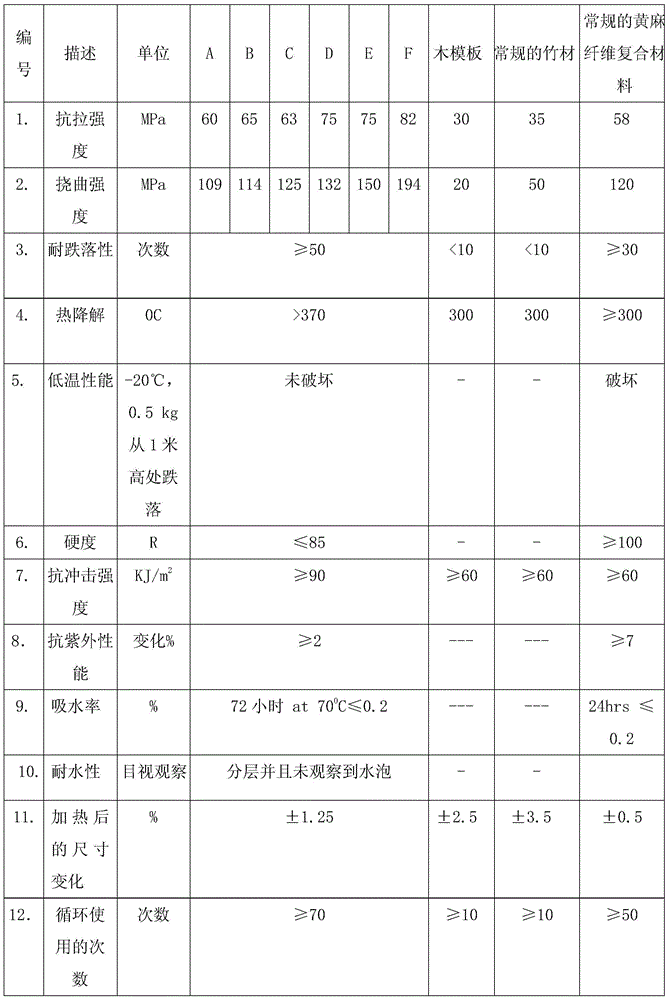A method of manufacturing biological source composite advanced composite material and product thereof
An advanced composite material and biological source technology, applied in the field of manufacturing biological source hybrid advanced composite materials, can solve the problems of high fatigue resistance, inability to impart, complex and expensive, etc., and achieve the effect of high tensile strength and bonding strength
- Summary
- Abstract
- Description
- Claims
- Application Information
AI Technical Summary
Problems solved by technology
Method used
Image
Examples
Embodiment 1
[0065] The jute mat and jute fibers were passed through a Doctor Box containing 0.5% maleic anhydride. The jute fiber mat and jute fibers were surface treated with maleic anhydride at 80°C and maintained at this temperature until the fiber mat entered another Doctor Box. The treated jute was then passed through another Doctor Box containing SBR Latex with 5% solids content. The SBR latex was grafted onto the treated jute fibers at 150°C and this temperature was maintained until the jute fiber mat was dehumidified. Then, the rubberized jute fabric was passed through phenolic in another Doctor Box. The treated jute is pulled out at a speed of 0.5 m / min, and the fiber is wound in a drum.
[0066] Rectangular shapes of raw material (phenolic impregnated jute) were kept layer by layer in proper sequence. The sequentially arranged prepregs are placed in a compression molding machine. at 150kg / cm 2 Under the pressure and temperature of 160 °C, the desired crosslinking and shape ...
Embodiment 2
[0068] The jute mat and jute fibers were passed through a Doctor Box containing 0.5% maleic anhydride. The jute fiber mat and jute fibers were surface treated with maleic anhydride at 50°C and maintained at this temperature until the fiber mat entered another Doctor Box. The treated jute was then passed through another Doctor Box containing SBR Latex with 5% solids content. The SBR latex was grafted onto the treated jute fibers at 90°C and this temperature was maintained until the jute fiber mat was dehumidified. Then, the rubberized jute fabric is passed through phenolic resin. The treated jute is pulled out at a speed of 0.2 m / min. The fibers are wound in the form of drums.
[0069] The component is shaped under tension using specially designed dies. The fabric is stretched in windings of roving and sandwiched in other natural fiber mats under an engineered frame, attached to a compression molding die. Keep the rectangular-shaped raw materials in a layer-by-layer struct...
Embodiment 3
[0071] The jute mat and jute fibers were passed through a Doctor Box containing 1.0% maleic anhydride. The jute fiber mat and jute fibers were surface treated with maleic anhydride at 80°C and maintained at this temperature until the fiber mat entered another Doctor Box. The treated jute was then passed through another Doctor Box containing SBR Latex with 20% solids content. The SBR latex was grafted onto the treated jute fibers at 150°C and this temperature was maintained until the jute fiber mat was dehumidified. Then, the rubberized jute fabric is passed through a phenolic resin. The treated jute is pulled out at 0.5 m / min and the fibers are wound in drums.
[0072] The rest of the steps were repeated as described in Example 1.
PUM
 Login to View More
Login to View More Abstract
Description
Claims
Application Information
 Login to View More
Login to View More - R&D
- Intellectual Property
- Life Sciences
- Materials
- Tech Scout
- Unparalleled Data Quality
- Higher Quality Content
- 60% Fewer Hallucinations
Browse by: Latest US Patents, China's latest patents, Technical Efficacy Thesaurus, Application Domain, Technology Topic, Popular Technical Reports.
© 2025 PatSnap. All rights reserved.Legal|Privacy policy|Modern Slavery Act Transparency Statement|Sitemap|About US| Contact US: help@patsnap.com



